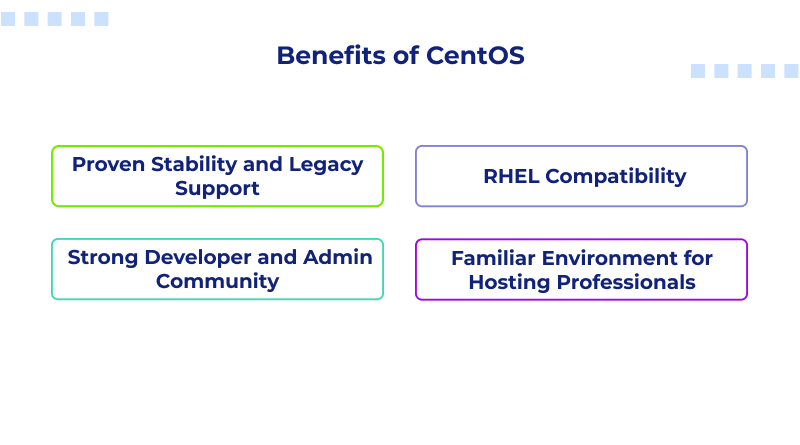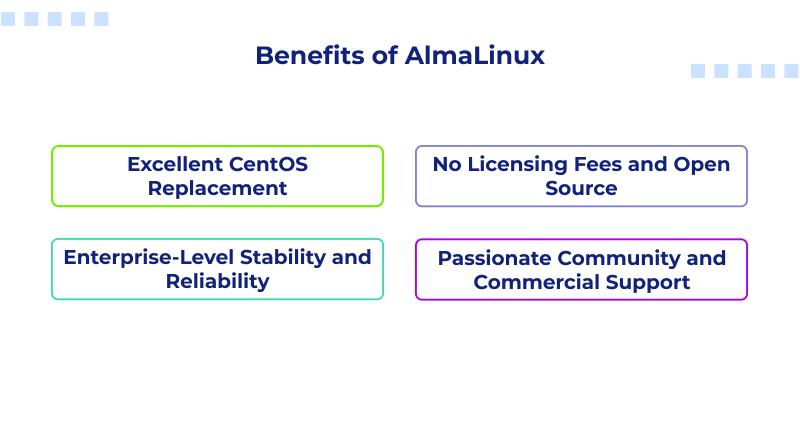Since the beginning of the internet, CentOS has been the most stable and most trusted open-source Linux Distribution, particularly for developers and owners of websites. Its stability, excellent performance, and close compatibility with Red Hat Enterprise Linux (RHEL) made it the go-to choice for web hosting. MilesWeb offers CentOS in the Linux VPS hosting plans, giving developers complete control of the server to build secure and scalable web applications.
Most of the users started looking for long-term, production-grade alternatives. CentOS users looking for production-grade alternatives have found a community-supported Linux distro in AlmaLinux to continue the CentOS legacy.
While CentOS vs. AlmaLinux are both RHEL compatible, the differences in structure, support systems, and long-term usability are crucial. Which of the two should you go for in your hosting environment?
This guide assesses CentOS and AlmaLinux in terms of performance, stability, security, and overall usability for web hosting to determine the differences in web hosting operations. This will allow you to identify the right Linux framework for your server management and project needs.
Table Of Content
Overview: What is CentOS?
CentOS, or Community Enterprise Operating System, is a free, open-source Linux distribution that has been widely used by developers, administrators, and website owners. Since it is designed to be functionally compatible with Red Hat Enterprise Linux, or RHEL, it has served as a robust and reliable OS for servers and enterprise environments for years.
CentOS was popular for RHEL’s enterprise-grade reliability without the licensing fees. Due to predictable updates and community-driven development, it became popular in the hosting sector for powering web servers, VPS hosting, and dedicated server environments.
In December 2020, Red Hat made a controversial change by announcing that CentOS will be an upstream project called CentOS Stream. This change meant that instead of RHEL, CentOS would take the rolling-release model set of stability for developers that they had come to rely on over the years.
Due to this change, a great number of organizations began to search for a true successor to CentOS that still provided the same reliability, compatibility, and long-term support for web hosting and enterprise operations.
Benefits of CentOS

1. Proven Stability and Legacy Support
For years, CentOS has been and still is one of the most trusted and stable Linux distributions while consistently performing and hosting millions of web servers. Even today, CentOS 7 and CentOS 8 systems remain in production across many businesses, offering a familiar and dependable platform for hosting applications, websites, and databases.
2. RHEL Compatibility
From the beginning, CentOS’s development focused on maintaining binary compatibility with Red Hat Enterprise Linux (RHEL). As a result, it positions itself as a product with high reliability and compatibility with enterprise applications.
It meant that CentOS users enjoyed RHEL’s unmatched performance and security, but without the expensive commercial licenses. As a result, CentOS became the operating system of choice for hosting providers and enterprise-grade projects.
3. Strong Developer and Admin Community
CentOS has a large, positive, and global network of system admin users and contributors. Because of this, there is a wealth of documentation, guides, and support for almost any technical issue that may arise.
Even with the changes that the CentOS organization made to provide CentOS Stream, a large portion of the old users, as well as the experts, have remained and continued to support the original environments.
4. Familiar Environment for Hosting Professionals
In the IT and development sectors, many of the professionals have grown and expanded their skill sets with CentOS. This creates a positive and well-integrated management experience when overseeing a server.
For hosts of legacy web applications, CentOS is of great value, as it requires little maintenance, a value that many old web environments prefer, and offers a consistent operating system.
Overview: What Is AlmaLinux?
Designed as a direct response to the loss of CentOS, AlmaLinux is a free, open-source, community-driven Linux distribution. Since it is a binary equivalent of RHEL, users receive the same enterprise stability that CentOS offers.
Initially called Project Lenix, it grew to be called AlmaLinux in January of 2021. Sponsored by the AlmaLinux OS Foundation, it is designed as a production-ready operating system to be a long-term solution for both developers and businesses.
AlmaLinux OS Foundation has released their first stable release to March 30, 2021, with support set to run until March 1, 2029. Of the many features that AlmaLinux offers, the AlmaLinux Build System (ALBS) remains one of the most notable, it offers community developers a transparent, reproducible ecosystem for the builds.
VPS AlmaLinux hosting quickly gained traction for enterprise workloads, cloud servers, and web hosting due to its long support cycle, transparent governance, and RHEL compatibility. It provides developers and companies using Linux VPS plans with a seamless and secure hosting ecosystem that is also ready for the future.
Similar Blog Topics:
- Rocky Linux vs AlmaLinux: Which Is Better for Your Server?
- AlmaLinux vs CloudLinux: Which OS is the Best for You
- AlmaLinux vs Ubuntu: Finding the Right Linux Distro for You
Benefits of AlmaLinux

1. Excellent CentOS Replacement
AlmaLinux was created to perfectly fill the gap left by CentOS. For the developers, web admins, and hosting providers migrating from CentOS, AlmaLinux maintains the same RHEL-based environment, facilitating smoother transitions and an easier adjustment period.
AlmaLinux lets users migrate their CentOS-based projects and servers without making any changes to their configurations. AlmaLinux offers long-term stability and support, making it ideal for users who prefer a conservative approach and do not want to deal with constant upstream changes associated with CentOS Stream.
2. Enterprise-Level Stability and Reliability
AlmaLinux offers a reliable production-grade enterprise operating system, maintained with regular and predictable updates. It continues to inherit the stability of RHEL, making it ideal for mission-critical workloads, including hosting servers, databases, and e-commerce systems.
Because it functions on a downstream release strategy from RHEL, all users receive timely and stable updates, which have passed levels of comprehensive testing, thus assuring system reliability and security for enterprise-grade hosting.
3. No Licensing Fees and Open Source
Distros like AlmaLinux are completely free and open source. Businesses can use them without worrying about licensing fees or restrictions. For other hosting providers, AlmaLinux means VPS and dedicated hosting can be provided without worrying about performance.
AlmaLinux offers high performance and enterprise-level functionality at no cost; small business websites and large enterprise applications can run cost-effectively on AlmaLinux.
4. Passionate Community and Commercial Support
AlmaLinux has a large and vibrant community of developers and system administrators. This means troubleshooting, resolving bugs, performance tuning, and timely updates are guaranteed.
In addition, AlmaLinux OS Foundation commercializes and sells support, which provides even more reliability for businesses. In the case of managed hosting clients, technical experts help configure, maintain, and optimize AlmaLinux systems for performance.
CentOS vs AlmaLinux: Key Differences
| Feature | CentOS | AlmaLinux |
| Type | Community-driven Linux distribution | Community-driven, RHEL-compatible Linux distribution managed by the AlmaLinux OS Foundation |
| Origin | Based on Red Hat Enterprise Linux (RHEL) | Forked from RHEL after CentOS Stream transition |
| Current Development Model | Upstream (CentOS Stream – testing ground for RHEL updates) | Downstream (stable version aligned with RHEL releases) |
| Stability | Highly stable in older versions (CentOS 7, 8) | Enterprise-grade stability for production environments |
| Long-Term Support (LTS) | CentOS 7 supported until June 2024 | Supported through 2029 (10-year lifecycle) |
| Community & Support | Legacy community support | Backed by an active open-source community and AlmaLinux OS Foundation |
| Commercial Backing | None (after Stream transition) | Supported and governed by a foundation with multiple sponsors |
| Migration Tools | Limited (since CentOS is now Stream-based) | Easy migration tools from CentOS to AlmaLinux |
| Target Users | Developers maintaining legacy or test environments | Businesses and developers seeking RHEL-stable production systems |
| Hosting Suitability | Reliable for legacy web projects | Best for modern web hosting, VPS, and enterprise workloads |
CentOS and AlmaLinux are both reliable options in the Linux hosting world. The best option for you depends on what you want to achieve and your vision in the long run. Similarly the difference between CentOS vs AlmaLinux, makes it easy to understand their benefits as per varied projects.
If you are maintaining older applications or dealing with systems that are still running on CentOS 7 or 8, choose CentOS. It is still a dependable legacy option in environments where feature updates are infrequent.
On the other hand, choose AlmaLinux if what you seek is a modern and stable RHEL-compatible operating system that is still under development and is readily available to the public for long-term support. It is the most suitable upgraded path for prior CentOS users to maintain an environment that is secure, up-to-date, and ready for production.
For developers and businesses using Linux VPS hosting, the choice is AlmaLinux. It merges the reliable performance of CentOS with a future-oriented, community-focused environment, making certain that hosting activities are secure, seamless, and uninterrupted.
FAQs
1. Is AlmaLinux any good?
Indeed, AlmaLinux is a great enterprise-grade Linux distribution. It is stable and secure and provides a great production environment because it has 1:1 binary compatibility with RHEL and provides long-term support with an active community. Hence, AlmaLinux is widely trusted for web hosting, cloud servers, and enterprise workloads.
2. Which OS has replaced CentOS?
The most popular CentOS replacements include AlmaLinux and Rocky Linux. These new operating systems were developed after Red Hat switched CentOS to a rolling-release model to provide users with long-term reliability and the same RHEL compatibility that CentOS offered.
3. What type of Linux is AlmaLinux?
As an enterprise-grade Linux operating system, AlmaLinux is free, open-source, and binary compatible with RHEL. This OS is geared towards a predictably stable, secure, and safe environment to run applications and servers and therefore appeals to businesses, developers, and hosting providers.
4. Is AlmaLinux like CentOS?
AlmaLinux is indeed highly comparable to CentOS in structure, functionality, and performance. It uses the same RHEL-based infrastructure that CentOS was famous for, providing a seamless migration for users. In essence, AlmaLinux is a continuation of CentOS as a dependable, community-based, and enterprise-grade Linux OS.








